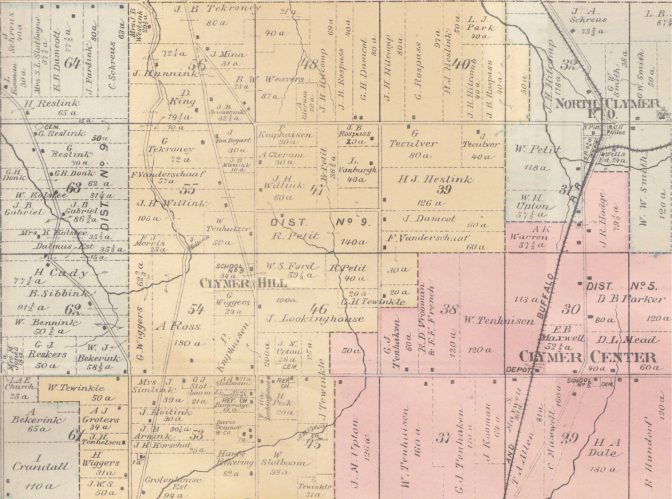Last week, I gave a lecture about emigration from the Achterhoek to America in the 19th century. I was invited by the historical society of Aalten, Dinxperlo and Wisch, of which I am a member. The interest was overwhelming, they kept having to find more chairs to seat everyone.
The Achterhoek is the eastern part of the province of Gelderland. Between 1840 and 1920, over 6,000 people from this region emigrated to the United States, mostly from the towns of Aalten, Dinxperlo, Varsseveld and Winterswijk. In the lecture, I explained the most important reasons for emigration (economy and faith), the migration patterns and destinations.

Fragment of a plat map of Clymer, Chautauqua county, New York in 1880, showing several Achterhoek names
Over 6,000 emigrants
For the past twenty years, I have been researching what happened to each of these 6,000+ emigrants. So far, I have been able to find over 4,000 of them in US records and a couple of dozen in South America and Canada.
How to find these emigrants
In the second half of the lecture, I discussed the methods I use to find out where these emigrants ended up.
The three main methods I use are:
- Understanding migration patterns. Most people settled where neighbors or family members went before.
- Searching for all Dutch inhabitants of a county where I find an immigrant.
- DNA.
My paternal ancestors all come from the Achterhoek. I took several DNA tests to test my autosomal DNA (the 22 pairs of non-sex chromosomes of which 50% get passed to each child after recombination). DNA testing is not very popular in the Netherlands. Most of my autosomal DNA matches are American descendants of these emigrants from the Achterhoek. Whenever I find matches who are willing to share their trees, I look if they had any Achterhoek ancestors and where they ended up. Often, they will be in the familiar destinations but every once in a while I discover a new cluster of emigrants this way. Finding emigrant clusters is a fascinating new way for me to use my DNA results, one I had not envisioned when I took the tests.
Slides
The lecture was in Dutch, and so are the slides. I am including them here for the Dutch readers of this website. The original lecture had mostly image slides but I added my presentation notes as text slides so the presentation makes sense if you weren’t able to attend the lecture.

